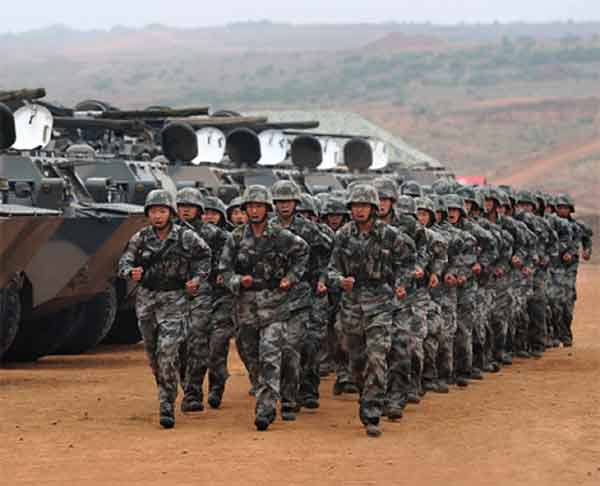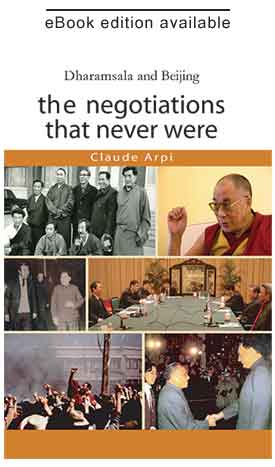In April 2013, the Chinese troops came 19 km inside the Indian Territory in the Depsang valley in Ladakh, a desolate area 40 km southeast of Daulat Beg Oldie, a World War II airstrip which was reactivated by the Indian Air Force in 2008 as part of India’s strategy to bolster border defence. It took hectic diplomatic efforts for almost two weeks before the Chinese troops withdrew ahead of Chinese premier Li Keqiang’s maiden official Indian visit in May.
…during the negotiations with China on border dispute, the politicians and bureaucrats lead the Indian side whereas the Chinese side is led by the senior defence officers who understand the ground realities better than Indian representatives.
More than a fortnight before Indian Defence Minister A K Antony’s scheduled visit to China, the People’s Liberation Army (PLA) troops had crossed over to the Indian side in the Chumar sector of southern Ladakh again on June 17 demolished temporary infrastructure and took away a solar powered security camera but later returned on July 3 just before the visit of Indian defence minister. Two Chinese army helicopters violated Indian airspace on July 11 in the Chumar sector in days after their soldiers intruded and took away an Indian surveillance camera.
Defence minister A K Antony led a four-day high-level delegation to China from July 4 to 7, his first since assuming the portfolio and two months after the standoff in eastern Ladakh and first since 2006. Antony’s visit was also to reciprocate last year’s visit of Chinese defence minister General Liang Guanglie to New Delhi, which took place after a gap of eight years. Antony must have been aware of the June 17 incursion of Chumar sector.
A Chinese PLA General, too, had warned India that it was occupying 90,000 sq km of disputed area from Arunchal to Ladakh, which he claimed belonged to China. Such incidents and statements reveal the real intention of the Chinese Army. But Indian defence minister did not raise this issue with the Chinese defence minister showing that India believes in soft paddling. China had also objected that India should not develop infrastructure like roads, airstrips and railways on its side of LAC, which should have been vehemently objected by Antony because China has already created highly modern infrastructure all along its side of the LAC.
Incidentally, Antony’s visit coincided with the visit of Pakistan Prime Minister Nawaz Sharif to China. While Sharif was given a red carpet welcome, Antony was snubbed when a Chinese Major General Luo Yuan deputy director general of the world military department of PLA warned India against stirring up ‘new trouble’ on the LAC hours before Antony landed in China.
There is enough space for both India and China to grow economically and politically and if they can do so with a spirit of accommodation and trust, it will contribute to Asia’s prosperity.
While no agreements were signed during the visit, the two sides advanced negotiations on the Border Defence Cooperation Agreement (BDCA), a new mechanism suggested by China last year for improving security at the borders. The BDCA, which has several facets, was discussed extensively between the two sides, especially during the June 28-29 border talks when National Security Advisor Shiv Shankar Menon visited China however not a single army expert was part of the negotiation team with NSA.
The two countries are strengthening the edifice of mechanisms that besides BDCA, the two sides were expected to finalise the dates to resume the military exercises which would focus on anti-terrorism drills. They have already finalised the modalities for the exercises, which would be held in Chengdu, close to Tibet. Armies of India and China held their first exercises in 2007 in Belguam in Karnataka with plans to hold such events annually. Similar exercises were held in 2008 at China’s Kunming city. The drills were later disrupted over China’s new policy of granting visas on piece of paper to residents of Jammu and Kashmir and Arunachal Pradesh and even denied visas to a top Northern Command general after which India rightly called off military contacts.
What is needed is mutual trust and mutual respect and here Antony scored a point in calling for closer military ties between the countries, which will help maintain peace along the borders. That is what Antony told the political commissar of National Defence University General Liu Yazhou. Antony also had wide-ranging discussions with Chinese premier Li Keqiang and defence minister Gen Chang Wanquan on a host of issues including maintaining peace and tranquillity at the borders. Antony had expressed interest to visit the top military academy to study the Chinese pattern as India has recently launched its National Defence University in Gurgaon, which was expected to be ready in the next few years.
China should realise that it is because of its belligerence India is strengthening its strategic ties with the Southeast Asian countries as a part of its Look East policy. India will also sign a trilateral maritime cooperation agreement with Sri Lanka and Maldives in July 2013 in a move to counter China’s bid to spread its strategic footprint in the Indian Ocean region. As a rising power with global ambition, China must demonstrate the right behaviour of a global power and not try to dominate others by use of force or the threat of its use. There is enough space for both India and China to grow economically and politically and if they can do so with a spirit of accommodation and trust, it will contribute to Asia’s prosperity.
India and China will sit down together for the first time after the Depsang incident to discuss border security and work on a defence cooperation agreement. Chinese officials from their foreign office and the Peoples Liberation Army will meet their Indian counterparts here on July 23-24.
For years, New Delhi neglected its defences on the China frontier, obsessing instead with its smaller but implacable adversary, Pakistan. But over the past seven or eight years, India’s strategic and military planners have drawn up a blueprint to beef up not only infrastructure but also to raise additional forces to counter Chinese military strength. Over the next few years, India is poised to add 90,000 soldiers, raise two mountain divisions, independent armoured brigades and artillery regiments under a corps and add muscle to air and naval power specifically meant to handle any potential military conflict with China.
At the same time, New Delhi will have to continue talking to Beijing and ensure the border is delineated as soon as possible without conceding any Chinese proposal to freeze troop strength at the current level. It is a tough balancing act but one that India’s political, bureaucratic and military establishment will have to manage if India is to stand up to the kind of aggression displayed by the hawkish PLA general.
Unfortunately, it has been observed that during the negotiations with China on border dispute, the politicians and bureaucrats lead the Indian side whereas the Chinese side is led by the senior defence officers who understand the ground realities better than Indian representatives. Why can’t the Chairman of the Chiefs of Staff Committee of the defence forces who understands defence and national security matters better be involved with political leadership in the decision-making on defence and national security issues?






